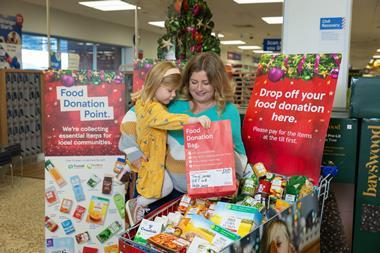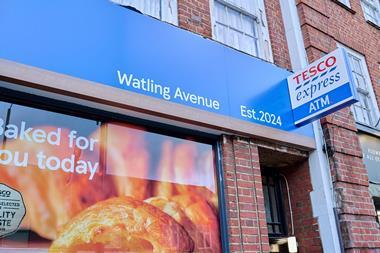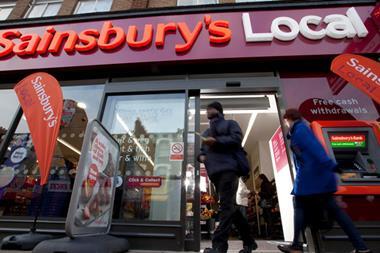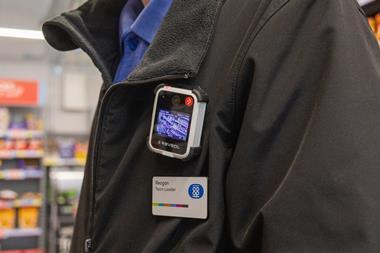Tesco has improved but availability is still causing headaches for suppliers and retailers says Siân Harrington
When chief executive Sir Terry Leahy stated in 2003 that he wanted Tesco to be number one for availability, it was clear there were going to be some big challenges ahead. Shoppers and suppliers were telling The Grocer that the UK’s biggest retailer had much to do to improve its out-of-stock position while Tesco.com in-store pickers were discovering on-shelf availability as low as 90%.
But a pronouncement by Sir Terry is not made lightly and less than two years later two barometers in The Grocer show the Tesco boss is tantalisingly close to realising his wish. Figures for The Grocer 33 from July to December 2004 put Tesco a hair’s breadth from Morrisons for availability of the items on our shopping list, at 97.6% compared with Morrisons’ 97.7%. Asda comes in at 96.6% while Sainsbury is a poor 94.9%.
And analysis of The Grocer’s monthly Stockwatch data from November 2003 to November 2004 shows Tesco well ahead of its rivals for availability of promoted lines across 12 categories and just behind Safeway and Sainsbury fascia stores for normal lines.
Our Stockwatch monitor is tougher than most availability surveys, as it measures products at risk of going out of stock during busy trading times. “At risk” is defined as items with less than 10% of stock left on the facing during peak periods. The monitor shows that the average across the six fascias for promotional products expected to go out of stock stood at 18.2%. Tesco came in well under this, at 13.6%, followed by Safeway at 17% and Morrisons at 17.7%.
The results show that Tesco’s strategy of investing in availability is paying off. Over the past year the retailer has unveiled a series of initiatives to help suppliers identify ways of simplifying replenishment, improving availability and boosting choice. Such initiatives enable suppliers to find better ways of improving the flow of goods from back of store to shelf, through techniques such as shelf-ready packaging, smaller case sizes or clearer labelling to help staff identify products in the store warehouse.
Rival Sainsbury, however, could do with taking a leaf out of Tesco’s book. The retailer, which recently said it wants to run fewer but deeper promotions, clearly has a problem maintaining stock levels on promoted stock, according to our monitor. Sainsbury had an average of 19.8% of promoted lines at risk of going out of stock over the 12 months.
But this was not as bad as Asda, which had a hefty 22.4% of promoted lines at risk. While signifying the popularity of such deals among customers, Asda obviously needs to work harder on in-store replenishment in categories in which stock flies off the shelf. “Asda was patchy. It was brought down by three or four categories, especially ice cream and sun protection,” explains Colin Harper, MD of Storecheck, which does the fieldwork each month for Stockwatch using its proprietary software.
In fact, the performance of all chains worsened in the summer as retailers were unable to keep up with rates of sale of sun protection products and ice cream. The latter saw the worst performances of the year, with a category average of 14% of normal lines and 26% of promotional lines affected by poor availability.
Asda shoppers appeared particularly keen to get a deal in these categories, leading to the fascia’s worst performances of the year, with 43% of promoted lines low or out of stock in both categories.
“It appears that shoppers are buying on deals more than ever. Rather than choosing promotions opportunistically they just want a deal. Consumers have been trained to do this thanks to the way retailers are strongly emphasising deals at the moment,” says director of Storecheck, Steve Smith.
He adds that both Asda and Tesco’s policies of de-cluttering manufacturer point of purchase material has led to greater conformity in-store and thus made it easier for consumers to pick out deals. “At Asda strong promotions fly off the shelves.”
Morrisons’ acquisition of Safeway and the worsening situation at Sainsbury throughout the year have also had an impact on both Tesco and Asda. “A lot of people who shopped at Safeway and Sainsbury have consolidated their shopping habits at Tesco and Asda. They are seeing better value but increased demand is affecting stock levels. If Sainsbury were stronger Asda would probably not have the availability issues it faces,” says Smith.
Morrisons’ troubles came with winter rather than summer products. It notched up the worst performance all year with 50% of promotional lines at risk or out of stock in cold and flu remedies in October.
Over at Somerfield, the key problem was confectionery, where 40% of promoted items were at risk. However, Somerfield delivered the best combined results in cereals, with only 8% of normal lines and 12% of promotional lines at risk of poor availability.
Somerfield also performed well in frozen ready meals. While it had the smallest range of all the chains studied, it had the most products on promotion at 15% of the category. Yet only 6% of skus on promotion were at risk and a low 8% of normal lines, compared to a category average of 15% of non-promoted skus and 9% of promoted.
Performances varied in this category, a point reiterated in The Grocer 33’s availability monitor for frozen food. When shoppers in October were asked to buy 10 specific items from the freezer, only Asda returned 100% availability, with Morrisons and Sainsbury each out of stock of one product and Tesco putting in its worst performance of the year with only seven items in stock.
To tackle availability, Harper believes both camps need to re-evaluate their ranging and category plans if they are to find a solution. “Progress cannot just come from expecting retailers to throw more labour in to improve availability, unless manufacturers are prepared to lose even more from the margin,” he says.
“Additional availability needs to come from reduction of facings on slower-selling lines, in some cases to zero.”
When chief executive Sir Terry Leahy stated in 2003 that he wanted Tesco to be number one for availability, it was clear there were going to be some big challenges ahead. Shoppers and suppliers were telling The Grocer that the UK’s biggest retailer had much to do to improve its out-of-stock position while Tesco.com in-store pickers were discovering on-shelf availability as low as 90%.
But a pronouncement by Sir Terry is not made lightly and less than two years later two barometers in The Grocer show the Tesco boss is tantalisingly close to realising his wish. Figures for The Grocer 33 from July to December 2004 put Tesco a hair’s breadth from Morrisons for availability of the items on our shopping list, at 97.6% compared with Morrisons’ 97.7%. Asda comes in at 96.6% while Sainsbury is a poor 94.9%.
And analysis of The Grocer’s monthly Stockwatch data from November 2003 to November 2004 shows Tesco well ahead of its rivals for availability of promoted lines across 12 categories and just behind Safeway and Sainsbury fascia stores for normal lines.
Our Stockwatch monitor is tougher than most availability surveys, as it measures products at risk of going out of stock during busy trading times. “At risk” is defined as items with less than 10% of stock left on the facing during peak periods. The monitor shows that the average across the six fascias for promotional products expected to go out of stock stood at 18.2%. Tesco came in well under this, at 13.6%, followed by Safeway at 17% and Morrisons at 17.7%.
The results show that Tesco’s strategy of investing in availability is paying off. Over the past year the retailer has unveiled a series of initiatives to help suppliers identify ways of simplifying replenishment, improving availability and boosting choice. Such initiatives enable suppliers to find better ways of improving the flow of goods from back of store to shelf, through techniques such as shelf-ready packaging, smaller case sizes or clearer labelling to help staff identify products in the store warehouse.
Rival Sainsbury, however, could do with taking a leaf out of Tesco’s book. The retailer, which recently said it wants to run fewer but deeper promotions, clearly has a problem maintaining stock levels on promoted stock, according to our monitor. Sainsbury had an average of 19.8% of promoted lines at risk of going out of stock over the 12 months.
But this was not as bad as Asda, which had a hefty 22.4% of promoted lines at risk. While signifying the popularity of such deals among customers, Asda obviously needs to work harder on in-store replenishment in categories in which stock flies off the shelf. “Asda was patchy. It was brought down by three or four categories, especially ice cream and sun protection,” explains Colin Harper, MD of Storecheck, which does the fieldwork each month for Stockwatch using its proprietary software.
In fact, the performance of all chains worsened in the summer as retailers were unable to keep up with rates of sale of sun protection products and ice cream. The latter saw the worst performances of the year, with a category average of 14% of normal lines and 26% of promotional lines affected by poor availability.
Asda shoppers appeared particularly keen to get a deal in these categories, leading to the fascia’s worst performances of the year, with 43% of promoted lines low or out of stock in both categories.
“It appears that shoppers are buying on deals more than ever. Rather than choosing promotions opportunistically they just want a deal. Consumers have been trained to do this thanks to the way retailers are strongly emphasising deals at the moment,” says director of Storecheck, Steve Smith.
He adds that both Asda and Tesco’s policies of de-cluttering manufacturer point of purchase material has led to greater conformity in-store and thus made it easier for consumers to pick out deals. “At Asda strong promotions fly off the shelves.”
Morrisons’ acquisition of Safeway and the worsening situation at Sainsbury throughout the year have also had an impact on both Tesco and Asda. “A lot of people who shopped at Safeway and Sainsbury have consolidated their shopping habits at Tesco and Asda. They are seeing better value but increased demand is affecting stock levels. If Sainsbury were stronger Asda would probably not have the availability issues it faces,” says Smith.
Morrisons’ troubles came with winter rather than summer products. It notched up the worst performance all year with 50% of promotional lines at risk or out of stock in cold and flu remedies in October.
Over at Somerfield, the key problem was confectionery, where 40% of promoted items were at risk. However, Somerfield delivered the best combined results in cereals, with only 8% of normal lines and 12% of promotional lines at risk of poor availability.
Somerfield also performed well in frozen ready meals. While it had the smallest range of all the chains studied, it had the most products on promotion at 15% of the category. Yet only 6% of skus on promotion were at risk and a low 8% of normal lines, compared to a category average of 15% of non-promoted skus and 9% of promoted.
Performances varied in this category, a point reiterated in The Grocer 33’s availability monitor for frozen food. When shoppers in October were asked to buy 10 specific items from the freezer, only Asda returned 100% availability, with Morrisons and Sainsbury each out of stock of one product and Tesco putting in its worst performance of the year with only seven items in stock.
To tackle availability, Harper believes both camps need to re-evaluate their ranging and category plans if they are to find a solution. “Progress cannot just come from expecting retailers to throw more labour in to improve availability, unless manufacturers are prepared to lose even more from the margin,” he says.
“Additional availability needs to come from reduction of facings on slower-selling lines, in some cases to zero.”

















No comments yet